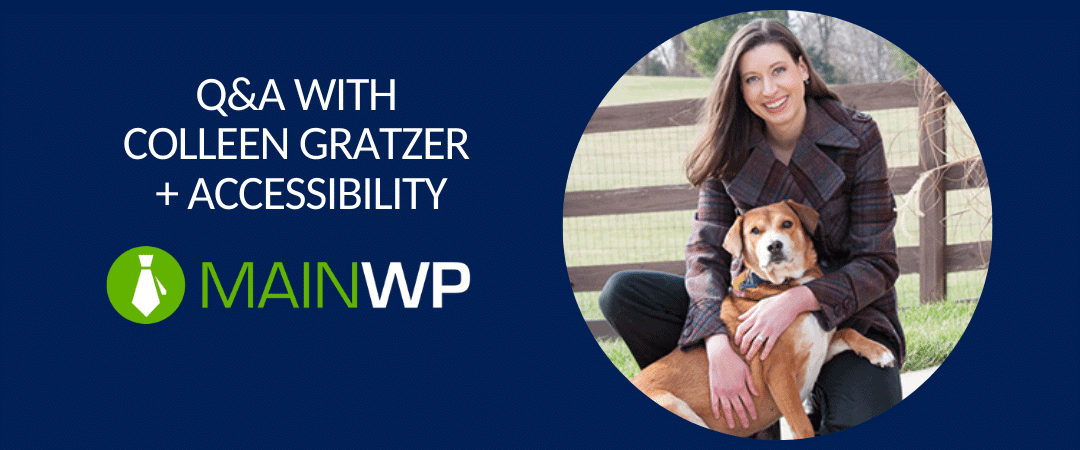Ever been to an outdated government website? I have. It’s frustrating.
Perhaps the website isn’t responsive or built on tables (yikes!). Even worse, it may not adhere to any accessibility standards.
We simply can’t ignore or take lightly the idea of accessibility in website design.
That’s one reason I brought Colleen Gratzer in to discuss the subject more.
You may have heard about the Domino’s lawsuit regarding accessibility.
“Guillermo Robles, who is blind, has tried to order a custom pizza from Domino’s at least twice in recent years, using the company’s website and mobile app.
“He says despite using screen reading software, he wasn’t able to order the food, because the website is not accessible to blind people.” Source: CNBC
With the Domino’s suit, these types of lawsuits are even more possible. Gratzer is here to help us be prepared.
This article is part 2 of our articles with Colleen Gratzer regarding accessibility. She also spends time talking about things we can learn in her course.
Do you have any advice for website designers who are looking to get started with learning accessibility? What resources do you recommend?
My advice is to take time to learn about accessibility before you implement it. If a client asks for an accessible site, and you don’t know much about accessibility, don’t just take it on and think you’ll just “figure it out” as you go.
I’ve heard of designers and developers doing that—building a site and then saying they’ll “just check it with a screen reader.”
Accessibility is about accessibility to all assistive technology, not just a screen reader. (Again, visual disabilities make up the smallest portion of all disabilities.)
It would not only be not profitable if you don’t understand what’s involved, but it could be a legal issue for you and your clients if it’s not done properly.
If you have little to no understanding of accessibility, I recommend the resources I listed above, especially the WP Elevation webinar.
It would not only be not profitable if you don’t understand what’s involved, but it could be a legal issue for you and your clients if it’s not done properly. Colleen Gratzer

What are some resources that website designers can use to improve their accessibility knowledge?
Some resources (a couple are my own) range from plain English to very technical or legal in nature.
Branding and Design
Guidelines
Informational
Legal
Website Accessibility
- Understanding and Selling Accessible Websites
- WP Elevation webinar
- Overlays and Plugins Aren’t the Answer to Accessibility
- Karl Groves’ findings about sites with accessibility overlays
What are the top 5 most important things website developers need to address for accessibility?
There are many I could list. But here are a few:
- Keyboard navigation
- Semantic HTML tags
- Presence of Alt-text on essential images
- Sufficient color contrast
- Use of form labels

What can students expect to learn in your Accessibility Course?
Students will learn the exact process that I have used, from understanding accessibility, talking about it with clients, building and testing the site, handing it off to clients, and how to continue helping the client.
An Understanding of Accessibility
Because the internationally accepted guidelines for accessibility—WCAG—are open to interpretation or are overwhelming and confusing to most designers and developers, my course is a plain-English approach based on my interpretation of and experience with the WCAG guidelines. I also mix in good usability practices because, technically, you could create a site that ticks off each guideline but doesn’t end up being accessible.
Students first learn what accessibility is, who it affects, how many it affects, why it’s important, and some of the laws. I also provide handouts to assist them with this, so they can have this info ready when talking with a client.
They’ll also understand and see demos of how someone using assistive technology or the keyboard gets around a site. (Not all users with a disability use assistive technology.)
Potential Legal Implications
They will find out some ways I protect myself in my contracts. Ignoring accessibility doesn’t protect you or your clients from potential lawsuits or hefty fines. There have been cases where a client had a claim made against them, then went after the web designer/developer. Just a couple of weeks ago, I heard from a web designer whose client was contacted by a lawyer about their site not being accessible.
Gain a Competitive Edge
Students will learn how accessibility gives them a competitive edge. Most web designers and developers are not having this conversation and do not know how to design and build an accessible website. Accessibility is a great way to stand out and add more value with this work.
Build Better Websites
They will learn how to build a better website, which helps their clients get a competitive edge. Typically, accessible websites are faster due to having leaner HTML code, and that can provide a boost in search engine rank.
Accessible websites also make it easier for all users (sighted or those with low to no vision) to find content on a page and get around the site.
They will learn a ton of best practices for accessibility and usability.
Get A Solid Process
They will learn a solid process that includes how to sell, design, build, and test websites for accessibility.
Make Ongoing Revenue
At the end of almost every module, I suggest ways that students can make money with accessibility right then, which, of course, is helping their clients not only be compliant but also reach more people.
Keep Learning
I also provide a handout with a ton of reliable resources for ongoing education on this topic. There is a lot of bad information out there, so you’ve got to know which experts you can trust.
WordPress Considerations
Most of the content is platform agnostic, but if a student is using WordPress, they will benefit from some of the WordPress-specific content: a custom plugin that helps their clients make more accessible updates to their page content.
They’ll learn how to identify accessibility issues in some themes and with page builders and WordPress (because no theme, page builder or WP is without issue).
Supplemental Materials
I provide a lot of handouts with each module to support the video content. In addition to that, I provide my actual website workflow checklist (which is 9 pages) along with text on best practices that you can give the client in the form of a guide. That helps them maintain the accessibility of their content.
They also get code snippets for adding functionality and styles to help with compliance.
Anyone interested in understanding more about accessibility and how it can help them and their clients can download my free guide, Understanding and Selling Accessible Websites.
You can find out more about my website accessibility course at https://academy.creative-boost.com/
Wrapping it up
Do you make sure your websites are accessible? How do you evaluate?
Have you had problems making websites accessible? How do you handle these tasks?
I want to thank Colleen Gratzer for sharing her expertise with us regarding accessibility.







